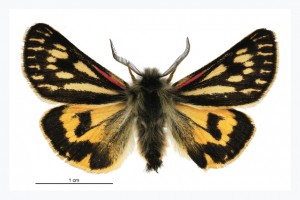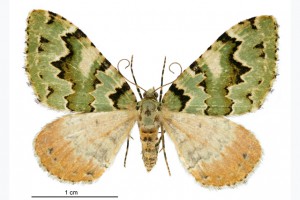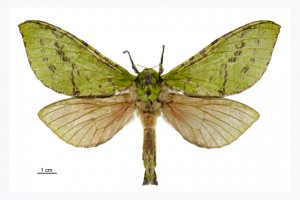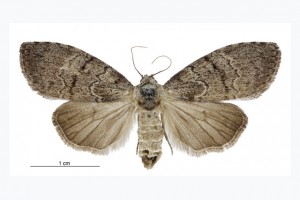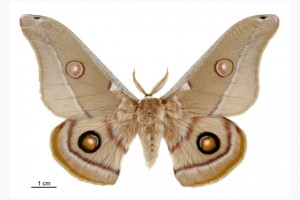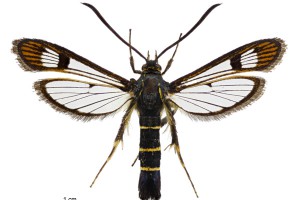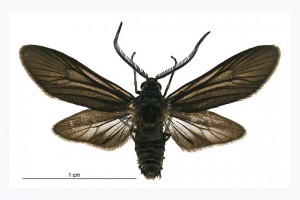Larger moths image gallery
To check details, click on a picture to see an enlarged version.
Image information
![[Nyctemera annulata] (female). Erebidae: Arctiinae. Image: Birgit E. Rhode [Nyctemera annulata] (female). Erebidae: Arctiinae. Image: Birgit E. Rhode](/assets/Tools-And-Resources/Identification/Moths/Erebidae/Nyctemera_annulata_female_Erebidae_Arctiinae__ResizedImageWzQwNSwyMzdd.jpg)
[Nyctemera annulata] (female). Erebidae: Arctiinae. Image: Birgit E. Rhode
The images in this online Guide are of pinned moths with their forewings and hindwings spread in the standard position for museum specimens.
When alive, most moth species rest with their hindwings concealed under the forewings, so initially some difficulty may be encountered in reconciling the appearance of the live specimen with these photos. However, if the moth can be captured in a transparent container and the forewing lined up so that it corresponds with the orientation in the photograph, comparison should be made relatively easy.
For the relatively few species where the hindwing shows important identification features, it may be possible to push the forewing gently forward with (e.g.) the point of a pencil to reveal the hindwing pattern. This is best done with a moth that is quiescent; refrigeration of the moth in its container for an hour or even overnight will do it no harm and make it easier to examine in this manner. As a general rule, the larger-bodied a moth is, the less it is likely to fly away when accorded such treatment!
(The gallery has been created from pinned specimens partly because this shows the full upperside colour pattern, and partly because to obtain excellent photographs of all New Zealand’s larger moth species live in the field would be the work of several lifetimes.)
Caution: There are MANY moth species in New Zealand. Some are very similar to one another, so it is necessary to exercise care in using this photographic guide. Look carefully at all the possible matches you can find in the gallery, but allow for variation in colour pattern. Only with experience will you get to know the range of variation exhibited by some of our commoner moths and be able to recognise them in all their various guises.
It is always good to take a photograph as a voucher, if the moth is thought to be something unusual or interesting. In some cases, it may even be advisable to collect a specimen, provided one has permission to collect from the landowner and/or other relevant authority, and collecting is undertaken in a responsible and ethical manner (see, e.g. Guidelines prepared by the Lepidopterists’ Society (USA)): http://butterflywebsite.com/Articles/collect.html ).
Short instructional videos relating to collecting and preparing moth specimens for study can be found at these sites:
Material credits
![[Xanthorhoe frigida] (female). Geometridae: Larentiinae. Image: John Early and Rosemary Gilbert (AMNZ, Auckland Museum, Auckland) [Xanthorhoe frigida] (female). Geometridae: Larentiinae. Image: John Early and Rosemary Gilbert (AMNZ, Auckland Museum, Auckland)](/assets/Tools-And-Resources/Identification/Moths/Geometridae/xanthorhoe_frigida_f_amnz__ResizedImageWzQwNSwyMzFd.jpg)
[Xanthorhoe frigida] (female). Geometridae: Larentiinae. Image: Birgit E. Rhode
The authors of this guide are very grateful to the following people, who assisted with loans of material for photography: John Early and Rosemary Gilbert (AMNZ, Auckland Museum, Auckland), Brian Patrick (BPNZ, private collection), Simon Pollard and Kate McCaughan (CMNZ, Canterbury Museum, Christchurch), Eric Edwards (EENZ, private collection), John Bain (FRNZ, Forest Research Institute Collection, Scion, Rotorua), John Marris (LUNZ, Entomology Research Museum, Lincoln University, Lincoln), Ricardo Palma and Phil Sirvid (MONZ, Museum of New Zealand, Wellington), and Otto Hyink and Cody Fraser (OMNZ, Otago Museum, Dunedin). The institutions and individuals named hold joint copyright in images of their specimens used in this online guide, as follows (m=male; f=female) (no Canterbury Museum specimens were eventually used for the guide):
AMNZ: Dasyuris octans f, ‘Hydriomena’ clarkei f, Pasiphila magnimaculata f, Xanthorhoe frigida f, Thysanoplusia orichalcea m,f, ‘Aletia’ sollennis m,f, ‘Andesia’ pessota m, Graphania chryserythra f, G. fenwicki m,f, Physetica caerulea m, Tmetolophota paraxysta f, T. phaula f.
BPNZ: Dioxycanus fuscus f, Dasyuris anceps grisescens f, D. enysii m, D. fulminea m, D. micropolis f, Helastia ohauensis m, Xanthorhoe frigida m.
EENZ: Wiseana copularis m, Asaphodes cinnabari f, A. dionysias m, A. helias m, A. ida f, A. stephanitis m,f, Dasyuris anceps anceps f, D. micropolis m, Epiphryne charidema charidema m,f, Homodotis falcata m, Notoreas paradelpha m, Pasiphila charybdis m, P. halianthes m, P. nebulosa m, P. rubella m, Pseudocoremia berylia m.
FRNZ: Artigisa melanephele f, Proteuxoa comma m, Phalaenoides glycinae m, ‘Aletia’ fibriata m, Ichneutica notata f.
LUNZ: Dasyuris catadees m, Helastia scissa m,f, ‘Hydriomena’ clarkei m, Notoreas arcuata f, N. chioneres/mechanitis f, N. isomoera m,f, Orthoclydon chlorias m, Pasiphila humilis f.
MONZ: Wiseana fuliginea f, Asaphodes abrogata m, A. adonis m, A. campbellensis m, A. citroena f, Austrocidaria lithurga m,f, A. venustatis m (holotype), Chloroclystis lichenodes m, Chrysolarentia subrectaria f, Dasyuris enysii f, D. pluviata f, D. transaurea m, Epyaxa lucidata m, Helastia cryptica m, Homodotis falcata f, Notoreas ischnocyma f, Orthoclydon chlorias f, Paranotoreas ferox m, P. fulva m, Pasiphila semochlora m, P. suffusa f, Tatosoma monoviridisata m,f, Xanthorhoe orophylloides m, Metacrias erichrysa m,f, M. strategica m, Titanomis sisyrota f, ‘Aletia’ argentaria m (holotype), ‘A.’ fibriata f, ‘A.’ panda m,f, ‘A.’ parmata f, Graphania chryserythra m, G. erebia m, G. morosa f, G. petrograpta m, Ichneutica cana m,f, I. ceraunias f, I. dione m,f, I. lindsayi m (second male), I. nervosa f, I. notata m, Meterana asterope f, M. decorata m,f, M. exquisita f, M. inchoata m,f, M. meyricci f, M. ochthistis m, M. pansicolor f, M. pauca m,f, M. pictula m,f, M. praesignis m, M. vitiosa m,f, Mythimna separata m, Tmetolophota acontistis f, T. alopa m, T. hartii f.
OMNZ: Asaphodes abrogata f, A. albalineata m,f, A. citroena m, A. exoriens m, A. frivola m, A. oraria f, A. oxyptera m,f, A. recta m,f, Dichromodes cynica m,f, D. gypsotis m,f, D. ida m,f, D. niger m,f, D. simulans m,f.
The specimen of Ctenoplusia limbirena photographed is from the private collection of A.W. Emmerson (Auckland)

